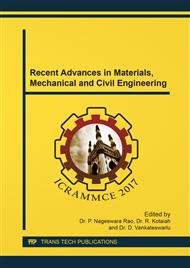p.378
p.384
p.391
p.397
p.403
p.409
p.414
p.430
p.436
Design Optimization of Flow Mode Magnetorheological Damper
Abstract:
To control the vibrations with passive suspension system having limitation with constant damping force. By using smart material like magnetorheological fluid, it is possible to control the damping performance of suspension system using current variations in magnetic coil. Applications of this kind of damper are in front loaded washing machine and damper use in driver seat of heavy duty vehicles. Mainly flow mode MR damper is most commonly used damper for these two applications. This paper represents theoretical model and optimized design of flow mode MR damper. For any kind of MR damper design of magnetic coil is play very vital role. So for this paper mainly includes the design of coil and different parameters like number of coil distance between two coil current passing from the coil is consider for design and optimization using FEMM software. This work also includes the theoretical study of MR damper characteristics with force-displacement and force velocity plot with change in piston diameter and fluid gap.
Info:
Periodical:
Pages:
403-408
Citation:
Online since:
February 2018
Authors:
Keywords:
Price:
Сopyright:
© 2018 Trans Tech Publications Ltd. All Rights Reserved
Share:
Citation:


